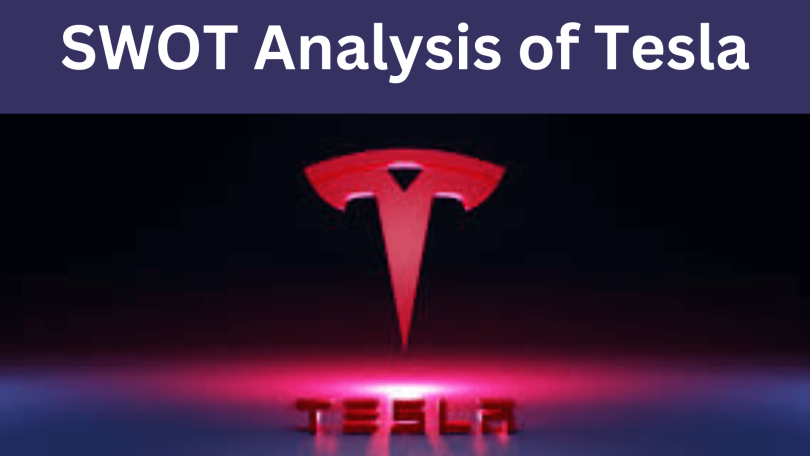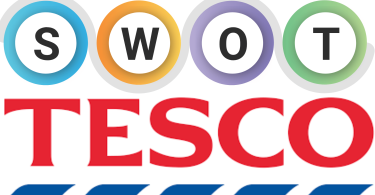In the ever-evolving automotive industry, where innovation and competition are fierce, understanding one’s strategic position is crucial for long-term success.
For Tesla, a leading force in electric vehicles and clean energy, conducting a SWOT analysis in 2024 offers more than just an internal review—it provides essential insights into the company’s strengths, exposes vulnerabilities, identifies growth opportunities, and highlights potential challenges.
This analysis is a roadmap to help Tesla refine its strategies, adapt to emerging trends, and stay ahead in the sustainability and technology integration race.
SWOT analysis of Tesla 2024
We now turn to the results of Tesla SWOT analysis:
The internal analysis of Tesla
The main goal of an internal analysis for Tesla is to gain a deep understanding of its strengths and weaknesses, by evaluating its internal factors.
This self-assessment helps Tesla management make informed decisions and develop effective strategies for the future.
Strengths of Tesla
Several key factors underscore Tesla’s competitive strengths in the automotive industry. According to our research, we have found the following strengths:
Market Leadership in Electric Vehicle (EV) Sales
In 2023, Tesla delivered approximately 1.8 million vehicles, a 38% increase from the previous year. This achievement solidified Tesla’s position as the world’s leading battery electric passenger car manufacturer, capturing a 19.9% market share.
Extensive and Proprietary Charging Infrastructure
Tesla’s Supercharger network is a significant advantage, offering over 15,000 charging stalls accessible to Tesla owners and, more recently, other EV brands.
This extensive network enhances the convenience of long-distance travel for Tesla drivers and contributes to the broader adoption of EVs.
Advanced Autonomous Driving Technology
Tesla’s Autopilot system is a leader in the industry, benefiting from continuous data collection from millions of vehicles on the road. This vast dataset enables Tesla to refine and enhance its self-driving capabilities more rapidly than competitors.
Industry experts recognize Tesla’s data-driven approach as a significant advantage in the autonomous vehicle race.
Strong Brand Recognition and Customer Loyalty
Tesla’s commitment to innovation and sustainability has cultivated a dedicated customer base and strong brand loyalty. The company’s direct-to-consumer sales model and emphasis on customer experience further reinforce its market position.
These strengths collectively position Tesla ahead of its competitors in the rapidly evolving automotive industry.
Innovation in Battery Technology:
Tesla leads the industry in battery research, working on advancements that improve battery life, energy density, and charging speed.
Tesla’s innovations allow its cars to offer longer ranges and more efficient power use than many competitors, making them attractive to EV buyers.
Strong Research and Development Capabilities:
Tesla consistently invests heavily in R&D, enabling it to bring cutting-edge technology to market faster than its competitors. This focus helps Tesla remain a front-runner in areas like autonomous driving, battery technology, and overall EV design.
First-Mover Advantage in EV Market:
Tesla’s early entry into the electric vehicle market helped it capture a significant share and establish a powerful brand. It has gained trust and brand recognition worldwide and is often seen as the EV movement’s face.
Effective Direct-to-Consumer Sales Model:
Tesla’s unique sales model, which eliminates third-party dealerships, allows for a more direct connection with customers. This model enhances customer experience, improves brand loyalty, and often results in better profit margins.
Weaknesses of Tesla
Tesla, while a leader in the electric vehicle (EV) market, faces several challenges compared to its competitors:
Production and Delivery Delays
Tesla has experienced notable delays in launching new models. For instance, the Cybertruck, initially announced in 2019, faced multiple postponements, with production starting in 2024.
These delays have allowed competitors to introduce their electric trucks, potentially capturing market share.
Quality Control Issues
The company has encountered quality concerns, including recalls. In April 2024, Tesla recalled nearly 3,900 Cybertrucks to address faulty accelerator pedals. Such issues can impact consumer confidence and brand reputation.
Limited Model Diversity
Tesla’s current lineup is relatively narrow, focusing primarily on sedans and SUVs. This limited range may appeal to only some consumer segments, especially as competitors offer a broader array of EV models, including trucks and compact cars.
High Price Points
Despite plans to introduce more affordable models, Tesla’s vehicles remain premium-priced. This pricing strategy may limit market penetration, particularly as other manufacturers release more cost-effective EV options.
Addressing these weaknesses is crucial for Tesla to maintain its competitive edge in the evolving automotive landscape.
Dependency on Single Production Facilities (e.g., Gigafactories):
Tesla relies on a limited number of Gigafactories for production, which makes it vulnerable to disruptions at any of these locations. Any issue, from labor strikes to natural disasters, could heavily impact production and deliveries.
Vulnerability to Negative Press and CEO Controversies:
Tesla’s CEO, Elon Musk, is a highly visible figure, and his public comments and actions can influence Tesla’s reputation. This visibility can be a double-edged sword, with Musk’s controversies sometimes leading to negative press and impacting stock prices.
Lack of In-house Supply Chain Control:
Tesla sources many parts from external suppliers, which exposes it to supply chain disruptions and limits its flexibility. Dependency on third parties for critical components can lead to production delays and higher costs.
Limited Presence in Budget and Mid-Range Market Segments:
Tesla’s vehicles are generally premium-priced, limiting their affordability for average consumers. This focus on the high-end market leaves an opportunity for competitors to capture more budget-conscious buyers interested in EVs.
The external analysis of Tesla
The primary objective of conducting an external analysis for Tesla is to understand external factors beyond its control that could influence its success in the global automotive industry.
This analysis helps Tesla’s management make well-informed decisions regarding its strategy, operations, and future trajectory. The external analysis delves into two main aspects: opportunities and threats.
Let’s move on to Teslas’ current and potential opportunities and threats without further ado.
Opportunities of Tesla
The global automotive industry is undergoing significant transformation, presenting numerous opportunities for growth and innovation:
Expansion of Electric Vehicles (EVs)
The shift towards electrification is accelerating, with EVs projected to constitute 50% of all global vehicle sales by 2041. This transition allows automakers to develop new EV models, invest in battery technologies, and establish charging infrastructure.
Integration of Advanced Technologies
Adopting technologies such as autonomous driving, vehicle-to-vehicle (V2V) communication, and 5G connectivity is reshaping the automotive landscape.
These advancements offer opportunities for companies to enhance vehicle safety, improve user experience, and create new revenue streams through software and services.
Development of Sustainable and Circular Economies
A growing emphasis on sustainability has prompted the industry to explore circular economy practices. This includes recycling materials, remanufacturing components, and reducing carbon footprints, aligning with global environmental goals and consumer preferences.
Growth in Emerging Markets
Emerging economies, particularly in Asia and Africa, present substantial growth prospects. Rising incomes and urbanization are increasing vehicle demand, offering opportunities for market expansion and localization of production.
Collaboration and Strategic Partnerships
The complexity of modern automotive technologies encourages collaborations between traditional automakers, tech companies, and startups. Such partnerships can accelerate innovation, reduce development costs, and facilitate entry into new markets.
Rising Demand for Renewable Energy Solutions:
As global focus on renewable energy intensifies, Tesla’s energy solutions, such as solar panels and energy storage systems (Powerwall and Powerpack), offer additional revenue streams. Tesla’s energy products align with government incentives and environmental policies, giving it an edge in this expanding market.
Expansion of Energy Storage Solutions (e.g., Powerwall, Powerpack):
Tesla’s battery technology can extend beyond vehicles to support residential and commercial energy storage. With growing interest in energy independence, Tesla can expand its energy storage offerings for homes, businesses, and utilities.
Increasing Focus on Autonomous Driving and Smart Vehicles:
Autonomous vehicle technology is advancing, and Tesla is well-positioned to benefit from this shift. With its data-rich fleet and AI capabilities, Tesla can capitalize on the potential revenue from self-driving software and services.
Growing Environmental Awareness and Government Incentives for EVs:
As more countries adopt stricter emissions regulations and incentivize electric vehicles, Tesla stands to gain from these policies. This environmental focus aligns with Tesla’s core mission, providing more market opportunities as demand for EVs increases.
Threats of Tesla
The global automotive industry faces several current and potential threats that could impact its stability and growth:
Economic Uncertainties
Fluctuating economic conditions, including inflation and rising interest rates, can reduce consumer purchasing power, leading to decreased vehicle sales.
For instance, in 2024, global auto sales are projected to grow by only 1.9% due to subdued consumer spending and sub-par global economic growth.
Supply Chain Disruptions
The industry continues to grapple with supply chain challenges, notably semiconductor shortages, which have hindered production and delayed vehicle deliveries.
While Tesla has managed these disruptions relatively well, the risk of future disruptions remains and could impact production schedules and delivery timelines.
Intensified Competition
The global automotive market is becoming increasingly competitive, with traditional automakers and new entrants, particularly from China, expanding their electric vehicle (EV) offerings. Chinese manufacturers produce high-quality EVs competitively, challenging Tesla’s market share.
For example, Chinese EV makers have made significant inroads into markets like Thailand and Brazil, posing a direct challenge to Western automakers.
Regulatory and Policy Changes
Stricter environmental regulations and evolving government policies require substantial investments in new technologies and compliance measures.
For example, Tesla’s Full Self-Driving (FSD) technology has come under scrutiny from regulatory bodies like the National Highway Traffic Safety Administration (NHTSA), which has initiated investigations due to reports of crashes.
These investigations could lead to recalls or restrictions, impacting Tesla’s operations and reputation.
Technological and Environmental Risks
Rapid technological advancements necessitate continuous innovation in areas like autonomous driving, connectivity, and electrification. Tesla must also address environmental and safety-related challenges, including recalls due to software issues and scrutiny over its Autopilot system.
In February 2023, Tesla recalled vehicles equipped with FSD Beta software due to concerns about traffic law compliance, affecting consumer confidence and leading to increased regulatory oversight.
Rapid Technological Changes and Need for Constant Innovation:
The automotive and tech industries are evolving quickly, requiring Tesla to keep up with EVs and autonomous technology advancements. This constant need to innovate can strain resources and potentially increase R&D costs.
Dependency on Volatile Raw Material Costs (e.g., lithium, cobalt):
Tesla relies on specific raw materials for its batteries, and prices for materials like lithium and cobalt can fluctuate significantly. Supply shortages or price increases impact production costs, hurting Tesla’s profit margins.
Cybersecurity Risks with Increasing Vehicle Connectivity:
As Tesla vehicles are highly connected and integrated with software, they face cybersecurity threats. Cyberattacks or data breaches could lead to safety risks, regulatory scrutiny, and damage to Tesla’s reputation.
Potential Backlash from Environmental Concerns Around Battery Disposal:
EV batteries, once expired, require careful disposal or recycling due to hazardous materials. Increased attention to the environmental impact of battery disposal could create new regulatory challenges and costs for Tesla, potentially affecting its eco-friendly brand image.
Tesla SWOT analysis matrix
To summarize the results of the Tesla SWOT analysis, we present the following SWOT matrix:

Conclusion
In conclusion, the company can explore several strategic options to ensure Tesla’s sustainability and growth in the coming years.
First, expanding its EV lineup to include more affordable models could broaden its customer base and solidify its market share.
Additionally, Tesla might consider forming partnerships with technology and battery companies to stay ahead in innovations for autonomous driving, energy storage, and battery efficiency.
Given recent supply chain challenges and competition from rapidly advancing foreign automakers, enhancing its global production and supply chain resilience is also essential.
Tesla’s management must conduct regular SWOT analyses to stay aligned with the fast-paced and evolving automotive landscape. A recurring assessment of Tesla’s strengths, weaknesses, opportunities, and threats will allow management to adapt strategies promptly and remain competitive.
However, a holistic view requires supplementing the SWOT analysis with additional tools like the PESTEL model to understand the broader macro-environment and Porter’s Five Forces model to assess competitive dynamics.
Read also: PESTEL analysis of Tesla in 2024.
SWOT Analysis Examples 2024
There is no better way to understand how to conduct a SWOT analysis at your company than with a concrete example.
Below you will find our free, up-to-date, and concrete examples of SWOT analyses of large companies and multinationals conducted in 2024.












Leave a Comment